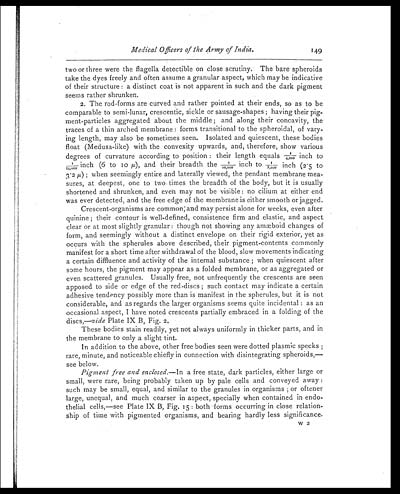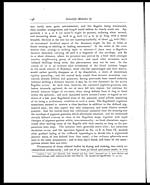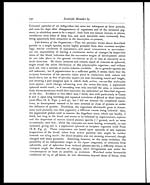Medicine - Institutions > Army health reports and medical documents > Scientific memoirs by medical officers of the Army of India > Part III, 1887 > 10 - Note on some aspects and relations of the blood-organisms in ague
(155) Page 149
Download files
Individual page:
Thumbnail gallery: Grid view | List view

Medical Officers of the Army of India.
149
two or three were the flagella detectible on close scrutiny. The bare spheroids
take the dyes freely and often assume a granular aspect, which may be indicative
of their structure: a distinct coat is not apparent in such and the dark pigment
seems rather shrunken.
2. The rod-forms are curved and rather pointed at their ends, so as to be
comparable to semi-lunar, crescentic, sickle or sausage-shapes; having their pig-
ment-particles aggregated about the middle; and along their concavity, the
traces of a thin arched membrane: forms transitional to the spheroidal, of vary-
ing length, may also be sometimes seen. Isolated and quiescent, these bodies
float (Medusa-like) with the convexity upwards, and, therefore, show various
degrees of curvature according to position: their length equals 1/4,000 inch to
1/25,000 inch (6 to10 µ), and their breadth the 1/10,000 inch to 1/8,000 inch (2.5 to
3.2 µ); when seemingly entire and laterally viewed, the pendant membrane mea-
sures, at deepest, one to two times the breadth of the body, but it is usually
shortened and shrunken, and even may not be visible: no cilium at either end
was ever detected, and the free edge of the membrane is either smooth or jagged.
Crescent-organisms are common; and may persist alone for weeks, even after
quinine; their contour is well-defined, consistence firm and elastic, and aspect
clear or at most slightly granular: though not showing any amæboid changes of
form, and seemingly without a distinct envelope on their rigid exterior, yet as
occurs with the spherules above described, their pigment-contents commonly
manifest for a short time after withdrawal of the blood, slow movements indicating
a certain diffluence and activity of the internal substance; when quiescent after
some hours, the pigment may appear as a folded membrane, or as aggregated or
even scattered granules. Usually free, not unfrequently the crescents are seen
apposed to side or edge of the red-discs; such contact may indicate a certain
adhesive tendency possibly more than is manifest in the spherules, but it is not
considerable, and as regards the larger organisms seems quite incidental: as an
occasional aspect, I have noted crescents partially embraced in a folding of the
discs,—vide Plate IX B, Fig. 2.
These bodies stain readily, yet not always uniformly in thicker parts, and in
the membrane to only a slight tint.
In addition to the above, other free bodies seen were dotted plasmic specks;
rare, minute, and noticeable chiefly in connection with disintegrating spheroids,—
see below.
Pigment free and enclosed. —In a free state, dark particles, either large or
small, were rare, being probably taken up by pale cells and conveyed away:
such may be small, equal, and similar to the granules in organisms; or oftener
large, unequal, and much coarser in aspect, specially when contained in endo-
thelial cells,—see Plate IX B, Fig. 15: both forms occurring in close relation-
ship of time with pigmented organisms, and bearing hardly less significance.
W 2
Set display mode to: Large image | Zoom image | Transcription
Images and transcriptions on this page, including medium image downloads, may be used under the Creative Commons Attribution 4.0 International Licence unless otherwise stated. ![]()
| Permanent URL | https://digital.nls.uk/75004471 |
|---|
| Shelfmark | IP/QB.10 |
|---|---|
| Additional NLS resources: | |




